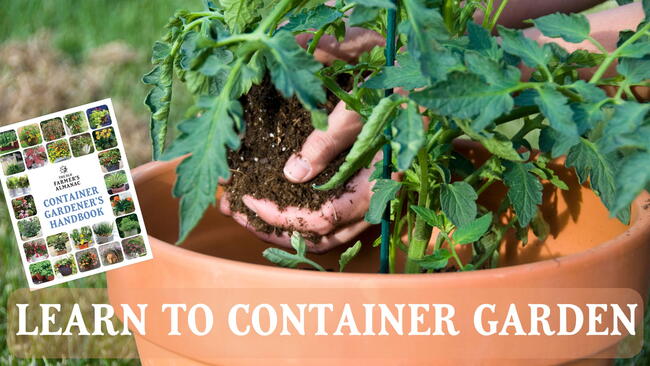Narrowing Your Choice of Tomatoes with Four Factors
There are thousands of tomato varieties, so how do you choose the best tomato for you (and your climate)? See four factors to help you narrow down your choice of tomato. Plus, find tips on giving your tomatoes a healthy start to life!
If you are a beginner gardener, you may wish to grow 2 or 3 plants of 2 or 3 different varieties to experiment. Let’s talk about how to choose tomatoes.
4 Factors When Choosing Tomatoes
1. Local Climate and Length of Growing Season
The first thing to consider is the length of your growing season. For every tomato variety, you want to look closely at “days to maturity” (listed in the description or on the seed packet). This indicates approximately how soon you can expect ripe fruit.
- Do you live in a cooler climate? We recommend looking for “early varieties’ which have a shorter growing season. An example is ‘Early Girl’ tomatoes (hybrid; indeterminate; round slicer; 59 days; disease-resistant). ‘Celebrity Tomato’ is also a favorite for gardeners who live in cold climates (hybrid, determinate, globe, 70 days, disease-resistant).
- On the other hand, if your summers are very hot it’s worth taking a look at some of the more modern varieties with improved heat tolerance. These tomatoes can set fruits at temperatures far higher than traditional varieties can. An example is ‘Florida 91’ (determinate; round slicer; 72 days; heat-tolerant; highly disease-resistant). An heirloom example is ‘Green Zebra’ (determinate, 78 days, green, small).
See our Planting Dates Calendar to get an idea of when you can start planting tomatoes (based on frost).
2. What You Will Do With the Fruit
Do you want to mainly use vine-fresh tomatoes for salads or make tomato sauce? Think about how you want to eat or cook with the fruit.
- Cherry and grape tomatoes range from pea to cherry-sized and are the sweetest to taste, making them ideal for children. Gardeners’ favorites include ‘Sweet Million,’ ‘Super Sweet 100,’ ‘SunGold,’ and ‘Juliet.’ See our post on growing cherry tomatoes!
- Roma, sauce, and paste varieties are high yielding and excellent for cooking because they contain plenty of flesh for sauce making. ‘Amish Paste’ is one of the most popular paste tomatoes (heirloom, indeterminate, 85 days,).
- Red slicers and beefsteak varieties bear large and often irregular-shaped fruits. These chunky, quirky fruits have an outstanding taste and texture that’s ideal for tomato salads. Gardeners’ favorites include ‘Big Beef,’ (hybrid), ‘Beefmaster,’ (hybrid), ‘Cherokee Purple’ (heirloom), and ‘Black Krim’ (heirloom).
- Other tomato varieties include heart-shaped oxheart types, hollow cavity tomatoes for stuffing, and early-to-mature pear tomatoes.
- There is a rainbow of colors to choose from: classic blood red, sunny yellow, antioxidant-packed purple or black, striped—the choice is yours!
3. Growing Habit: Determinate vs. Indeterminate
Tomatoes are either determinate—which means they grow to a predetermined height—or indeterminate, where the main stem keeps on growing.
- Determinate, or ‘bush’ tomatoes, stop growing at 2.5- to 4-feet tall. The tomatoes all ripen within a relatively short period of time (1 week to 10 days), so they are best for making sauces and canning. A popular determinate tomato is ‘Celebrity,’ a round slicer. For gardeners with small spaces such as a patio or balcony, bush varieties are also a preferred option.
- Indeterminates, or vining tomatoes, are plants that keep growing and produce fruits along a stem. Many gardeners prefer indeterminate varieties because they set fruit over the summer and stagger the bounty, giving a steady crop. Vine tomatoes often grow up to head height so they require tall supports such as bamboo canes or tomato cages. Gardeners favorites include ‘Early Girl’ (round slicer) and ‘Better Boy’ (beefsteak).
Tumbling tomatoes offer a compact alternative for hanging baskets and tubs—perfect for those with a small garden or a balcony. ‘Tumbling Tom’ is one popular tomato for hanging baskets.
4. Disease Resistance
If you’ve ever grown tomatoes, you’ll start to know more about the commonly occurring issues in your area. Many diseases are related to climate (such as wet, warm weather). You can also ask your local nurseries, your local Master Gardeners office, or neighboring home gardeners. They can tell you if certain tomato diseases are common in your area.
Take preventative action by selecting varieties with built-in resistance to diseases, and ensuring the right growing conditions.
For example, many tomato varieties are resistant to soil-borne diseases, and seed packets or catalogs indicate this by putting F (fusarium), V (verticillium), or N (nematodes) after the variety name. You’ll also see varieties that are resistant to viruses, such as tomato mosaic virus (T) and Alternaria (A), the fungus that causes early blight.
In temperate areas, late blight is the disease that every tomato grower dreads, as it strikes during periods of warm, wet weather. Caused by a fungus (Phytophthora infestans), blight can destroy plants in as little as one week. The spores are carried up to 30 miles in the wind, so the only real way of avoiding blight is to either grow tomatoes under cover or select one of the new blight-resistant varieties.
Alternatively, grow fast-maturing tomatoes, such as cherry tomatoes, which can give a harvest before the threat of blight arrives. Cherry tomatoes, including “Juliet” (hybrid) and Tommy Toe (heirloom), are both resistant to early blight.
Learn more about tomato diseases and disorders.
Tips on Sowing Tomatoes
Many beginner gardeners start their tomatoes from small plants purchased through an online catalog or at a garden center. If it’s after your frost date, it’s too late to sow tomatoes from seed.
However, if you wish to sow seeds, you would start them 6 to 8 weeks before planting, working back from your last frost date. Sow the seeds individually into pots or trays of damp seed-starting mix. Cover them over with a fine layer of potting soil, and water carefully, then place the pot into a propagator or secure a clear plastic bag over the top of the pot to create a humid microclimate. Keep the pot in a warm location out of direct sunlight. A temperature of about 70 degrees Fahrenheit is ideal. You’ll generally need supplemental Grow Lights to have enough light for tomatoes.
As soon as the seeds have germinated, move them into a bright location. Turn windowsill seedlings regularly if they start to lean towards the light. Again, grow lights can give an early boost and promote upright growth. Move your seedlings into their own pots as soon as they start to form their first adult leaves. Prepare potting soil-filled pots by dibbing holes ready for the seedlings. Remove the seedlings from their nursery pot, then handle them carefully by their leaves to avoid damaging the delicate stems, and lower each seedling into its hole. Gently feed the roots down into the hole and bury the seedlings right up to the first leaves to produce a much sturdier plant.
Grow your tomatoes on at about 60 to 65 degrees Fahrenheit. Nighttime temperatures can drop a bit lower than this and will help to encourage stronger plants. If the roots fill their pots before it is time to plant them out, simply pot them into a larger container using fresh potting soil.
Growing Tomato Plants Outdoors
Outdoor tomatoes will first need acclimatizing to outside conditions to avoid cold shock. If the plants have been inside a greenhouse, harden them off over a period of two weeks. Begin by leaving plants outside for just a couple of hours a day then gradually increase the length of time they spend outside, avoiding windy days. Bring plants under cover if temperatures threaten to drop below 40 degrees Fahrenheit. Plant outside only after all danger of frost has passed.
There are many, many varieties of tomato to explore—enough for a lifetime of discovery! Unless you are relying on your garden as your only food source, part of the fun is learning about the amazingly delicious tomatoes out there and which appeal to you! Don’t forget to include a delicious heirloom variety!
For more information, see the Almanac’s Complete Guide to Growing Tomatoes from planting to harvesting.
Cat poop and urine can be damaging to plants and is dangerous to human health. However, as long as you remove it from the garden, it is unlikely to cause an issue. If the cats are pooping right around the base of the plant, consider putting up cages or wiring around the plants to keep them away. If the cats are going on the mulch, it will provide a good layer of protection and prevent the waste from directly getting into the soil, but you will still want to be diligent in removing any waste, as well as the mulch or soil immediately around it. Additionally, when you harvest the tomatoes, you should wash them thoroughly before consumption. Consider putting chicken wire or some other fencing around the entire garden bed to keep cats away.









